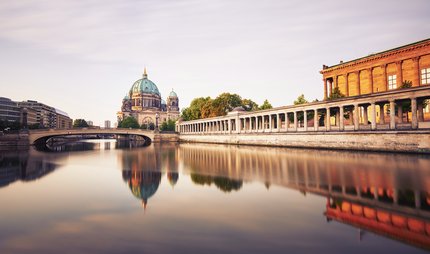
Pergamon Museum
The Pergamon Museum is closed for renovation
Please note: The Pergamon Museum is closed to carry out extensive renovation work. In 2027, the north wing with the Pergamon Altar will be on view again as the first completed construction phase.
The Pergamonmuseum is closed, but the exhibition "Pergamonmuseum. The Panorama" with the 360-degree panorama by Yadegar Asisi and antique originals from Pergamon allows visitors to experience the Pergamon Altar in its original form and in its urban context on the Acropolis. It is located opposite the Museum Island.
The Pergamon Museum, which is now closed, harbours great cultural treasures: With the shimmering turquoise-coloured Ishtar Gate and the monumental Market Gate of Miletus from antiquity, the imposing building on the Museum Island is impressive. The Processional Way of Babylon was built more than 2,600 years ago. Behind the Ishtar Gate, the world of classical antiquity opens up. The question inevitably arises: How did the ancient peoples manage to build structures of such dimensions and with such rich ornamentation? The museum also houses architectural masterpieces from the Near East and classical antiquity as well as magnificent works from the Islamic culture.

Babylon and the Near East - the story
After the famous merchant and archaeologist Heinrich Schliemann uncovered Troy, excavation fever broke out in the 19th century. German researchers travelled to Pergamon, Miletus, Babylon, Uruk, Assur and Egypt. The Ottoman Empire granted generous conditions for sharing finds, which is why important architectural monuments, sculptures and small artefacts were exported to Berlin. Their finds are soon exhibited on Berlin's Museum Island, in the predecessor building to the Pergamon Museum. But after a short time, the space was no longer sufficient. Between 1910 and 1930, the Pergamon Museum was built according to plans by architect Alfred Messel. It soon became one of Berlin's main attractions. In addition to the imposing Pergamon Altar - the pinnacle of Hellenistic art - the 17 metre high Market Gate of Miletus and the magnificent Ishtar Gate form the core of the exhibition. The Pergamon Museum comprises three collections: Parts of the Antique Collection in the central building, the Foreign Asian Museum on the main floor of the south wing and the Museum of Islamic Art on the upper floor.
About the Museum of the Ancient Near East: Reaching from floor to ceiling are the dimensions of the shimmering blue Ishtar Gate from Babylon.


Spectacular: The imposing market gate of Miletus, a splendid example of Roman imperial architecture from what is now western Turkey, featuring two storeys with richly decorated columns, beams and pediments.

The mshatta façade from a desert residence of Umayyad caliphs in present-day Jordan is rich in filigree stucco walls. It belongs to the Museum of Islamic Art.

The Islamic Museum's collection also includes a magnificent dome from the Alhambra in Granada and prayer niches from Turkey and Iran.
Highlights of the collection in the Pergamon Museum
- The famous Ishtar Gate from Babylon
- The Pergamon Altar of Asia Minor with its elaborate reliefs (currently closed)
- Roman market gate from Miletus from the early 2nd century AD
- . century AD
- the intricately designed mshatta façade from one of the Jordanian desert castles
- Statuette of the Prayer from Assur
Our recommendations: Nearby attractions
Explore the Museum Island. The highlight of the New Museum is the famous bust of Nefertiti. The museum also presents an authentic Egyptian courtyard, mummies and valuable papyrus scrolls. Right next door at the Lustgarten, you are greeted as soon as you enter the Old Museum, you are greeted by the mighty rotunda dome. Behind the columns and sculptures, you reach the collection of Roman and Greek sculpture. The Alte Nationalgalerie, on the other hand, is for lovers of German painting. Classics such as Caspar David Friedrich and the landscape painter Carl Blechen take centre stage. The Brandenburg Gate, Friedrich Wilhelm von Schadow, is the sculptor of the Quadriga on the Famous Princess Group. In the northern part of Museum Island is the Bode Museum with its striking copper dome. Inside the imposing building, the Coin Cabinet and the Museum of Byzantine Art invite you to take a fascinating tour.



